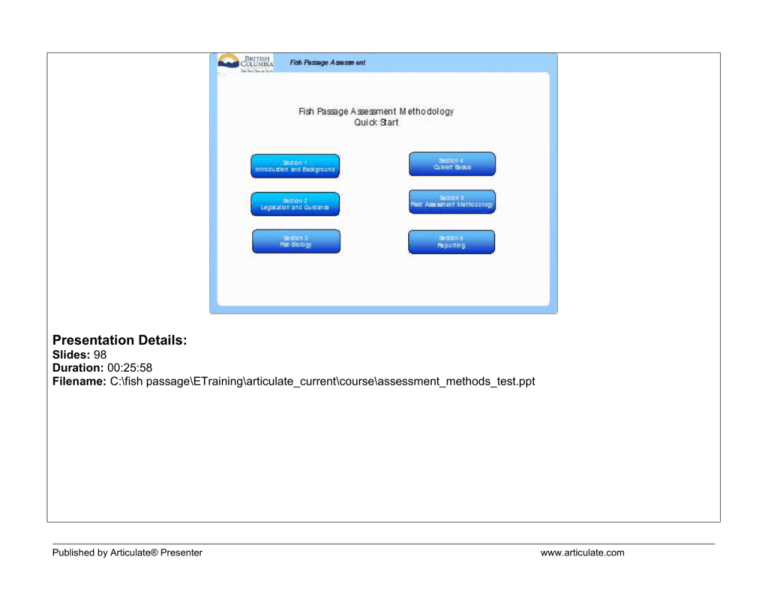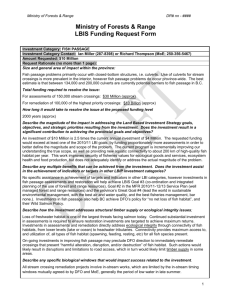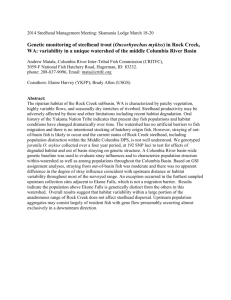storyboard_sec3_fish biology_NG
advertisement

Presentation Details: Slides: 98 Duration: 00:25:58 Filename: C:\fish passage\ETraining\articulate_current\course\assessment_methods_test.ppt Published by Articulate® Presenter www.articulate.com Slide 26 Section 3: Fish Biology Notes: Duration: 00:00:05 Advance mode: Auto "Hello my name is Peter Tschaplinski. I am the Manager of the Fish-Forestry Interactions and Watershed Research for the BC Ministry of Forests and Range. This section of the course covers off some basic fish biology as it relates to fish passage and culverts. It is important to have a basic understanding of fish biology so as to understand the interaction of culverts on fish movement and life cycle requirements. On completion of this section, learners will be able to demonstrate an understanding of basic fish biology and how culverts can impact access to critical habitats, as well as the where, when and how is it important for fish to be able to pass through culverts." Slide 27 Bull Trout Life History Notes: Duration: 00:00:05 Advance mode: Auto Presenter Details: Name: Peter Tschaplinski Title: Manager, Fish-Forestry Interactions and Watershed Research, Ministry of Forests and Range Email: peter.tschaplinski@gov.bc.ca So, to illustrate the importance of providing year round access to various habitats lets look at Bull trout, a relatively long lived species. Migration to spawning habitats occurs April to September with spawning taking place between September to November. Eggs are deposited in the gravel with incubation occurring October to January. The eggs hatch January to February with fry emerging April to June. Juvenile development and dispersal occurs August to October. Bull Trout are resident in streams and lakes within BC and can live upwards of 13 years. As you can see, the life-cycle of Bull Trout requires access to various habitats throughout the year so restrictions to their mobility can have significant impacts to their well-being. Published by Articulate® Presenter www.articulate.com Slide 28 Freshwater Residence Period by Species and Life Stage Duration: 00:00:05 Advance mode: Auto Presenter Details: Name: Peter Tschaplinski Title: Manager, Fish-Forestry Interactions and Watershed Research, Ministry of Forests and Range Email: peter.tschaplinski@gov.bc.ca Notes: Let’s quickly look at the freshwater residency of some other species in BC. Looking at the table above you can see that some species particularly coho and chinook salmon and the ever ubiquitous rainbow trout are resident in BC streams in some life stage the entire year. The take-away message from this table is that we have in BC a diverse fish population and that most fish-bearing streams in BC have numerous species. So when you look at the life history of these species, the specific habitat needs are diverse and culvert blockages or restrictions to various habitat types can be very limiting healthy fish populations. So let’s have a look at some of these habitat needs… Slide 29 Fish Habitat Requirements Notes: Duration: 00:00:05 Advance mode: Auto Presenter Details: Name: Peter Tschaplinski Title: Manager, Fish-Forestry Interactions and Watershed Research, Ministry of Forests and Range Email: peter.tschaplinski@gov.bc.ca In very general terms, fish require a number of different habitat types. They require conditions suitable for migration to access the various habitats that they use. They require suitable spawning habitat - conditions that may vary depending on the size and species of fish concerned. They require areas that have favourable conditions for rearing and feeding such as pools or riffle areas. Keep in mind that these needs may varying depending on such factors as water levels, stream velocities or temperature conditions. Another important habitat types include high-water refugia and over-wintering areas. These habitat types are especially important for coho and steelhead juveniles as they seek out conditions that allow them to survive the higher winter flows often found in main-stem streams. Finally, it should be remembered that downstream migration is also important for fish, Published by Articulate® Presenter www.articulate.com so the culvert must be passable in both directions. Some culvert conditions may not be survivable for fish moving in a downstream direction. So let’s recap these habitat types with some pictures so we have a good metal image of what they look like… Slide30 Word Quiz Interaction type: Word Quiz Passing score: 100 Instructions: None Custom Message: None Slide 31 Questions: 1. Name an important habitat type Answer: rearing and feeding area Migration Corridors Notes: Duration: 00:00:05 Advance mode: Auto Presenter Details: Name: Peter Tschaplinski Title: Manager, Fish-Forestry Interactions and Watershed Research, Ministry of Forests and Range Email: peter.tschaplinski@gov.bc.ca Culverts are obviously important in relation to migration. Fish generally move a lot within systems. It is not only adults that move, juveniles move about stream as stream conditions or habitat needs change as well. Slide 32 Access to Suitable Spawning Habitat Notes: Duration: 00:00:05 Advance mode: Auto Presenter Details: Name: Peter Tschaplinski Title: Manager, Fish-Forestry Interactions and Watershed Research, Ministry of Forests and Range Email: peter.tschaplinski@gov.bc.ca Fish seek out areas of suitable spawning habitat…. Published by Articulate® Presenter www.articulate.com Slide 33 Access to Rearing and Feeding Areas Notes: Duration: 00:00:05 Advance mode: Auto Presenter Details: Name: Peter Tschaplinski Title: Manager, Fish-Forestry Interactions and Watershed Research, Ministry of Forests and Range Email: peter.tschaplinski@gov.bc.ca Fish need access to favourable rearing and feeding areas… Cover and stream diversity are important. Slide 34 High Water Refuge and OverWintering Habitat Duration: 00:00:05 Advance mode: Auto Presenter Details: Name: Peter Tschaplinski Title: Manager, Fish-Forestry Interactions and Watershed Research, Ministry of Forests and Range Email: peter.tschaplinski@gov.bc.ca Published by Articulate® Presenter Notes: Fish move seasonally and during periods of high water… especially important for coho and steelhead juveniles. www.articulate.com Slide 35 Out-Migration Notes: Duration: 00:00:05 Advance mode: Auto Presenter Details: Name: Peter Tschaplinski Title: Manager, Fish-Forestry Interactions and Watershed Research, Ministry of Forests and Range Email: peter.tschaplinski@gov.bc.ca Fish move in both directions.. Conditions must be favorable for downstream movement as well!.. Slide 36 Now that we have looked at the broad categories of habitat types that fish depend on, let’s spend a moment looking at another key biological factor – swimming ability…. Fish Swimming Ability Notes: Duration: 00:00:05 Advance mode: Auto Presenter Details: Name: Peter Tschaplinski Title: Manager, Fish-Forestry Interactions and Watershed Research, Ministry of Forests and Range Email: peter.tschaplinski@gov.bc.ca Obviously, a fish’s ability to negotiate a culvert is dependent on it’s swimming ability. So what influences this ability? What are some of the key factors? Lets list some.. Slide 37 • • • • • Level of exertion Fish size Relative capabilities of different species Swimming length without rest Other: distance already traveled, turbidity, temperature, oxygen levels, water depth, disease, water velocity Relative Fish Swimming Speeds Notes: Duration: 00:00:05 Advance mode: Auto Presenter Details: Name: Peter Tschaplinski Title: Manager, Fish-Forestry Interactions and Watershed Research, Ministry of Forests and Range Email: peter.tschaplinski@gov.bc.ca So let’s look at swimming speeds of some common BC fish. The graph presented shows speeds for both adult and juvenile coho salmon as well as steelhead and cutthroat. They are broken down into cruising, sustained and darting speeds. Cruising speeds are those that can be maintained for long periods of time such as for hours. Sustained speeds are those that can maintained for shorter periods of time such as minutes and are often the speed used to negotiate obstacles while darting speeds are those resulting from a single momentary effort Published by Articulate® Presenter www.articulate.com and therefore not sustainable. Typically, juveniles such as shown for Coho can sustain speeds of up to 2 feet per second.. A relatively slow speed, one in which could be expected in culverts installed at slopes less than 1 %. Larger adults such as Coho and Steelhead have much higher sustained speeds ranging anywhere from 4 feet per second to over 12. In addition to velocity, turbulence also makes culverts difficult to negotiate. Washington State design guidelines require culvert velocities for adult fish to range between 2.0 and 6 feet per second depending on species. For juveniles, Washington State guidelines call for velocities closer to 1 fps when juveniles are a consideration. These velocities are expected 90 % of the time during migration of the target species and age-classes. So this section covered off some basic fish biology as it relates to culverts. Time now for a short quiz on what we covered. Slide 38 Quiz 3: Fish Biology Notes: Duration: 00:00:00 Advance mode: Auto Welcome to the quiz on the material we have covered fish biology. There are 10 questions to answer in various formats. You must answer a minimum of 8 questions correctly to advance to the next section. At completion of the quiz you can either print out your results or review on-line. Start whenever you are ready Published by Articulate® Presenter www.articulate.com








